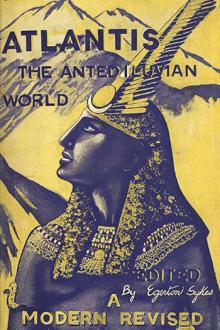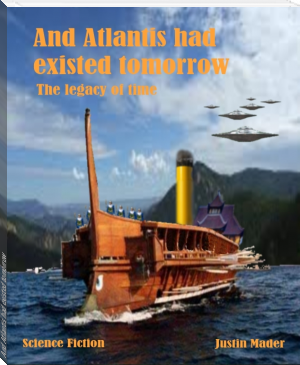Atlantis: The Antedeluvian World by Ignatius Donnelly (thriller novels to read .TXT) 📕

- Author: Ignatius Donnelly
- Performer: -
Book online «Atlantis: The Antedeluvian World by Ignatius Donnelly (thriller novels to read .TXT) 📕». Author Ignatius Donnelly
It will be observed that in all these legends the name of Zeus, King of Atlantis, reappears. It would appear probable that many parties had escaped from the catastrophe, and had landed at the different points named in the traditions; or else that colonies had already been established by the Atlanteans at those places. It would appear impossible that a maritime people could be totally destroyed; doubtless many were on shipboard in the harbors, and others going and coming on distant voyages.
“The invasion of the East,” says Baldwin (‘Prehistoric Nations,’ p.
396), “to which the story of Atlantis refers, seems to have given rise to the Panathenæ, the oldest, greatest, and most splendid festivals in honor of Athena celebrated in Attica. These festivals are said to have been established by Erichthonis in the most ancient times remembered by the historical traditions of Athens. Boeckh says of them, in his ‘Commentary on Plato:’
“‘In the greater Panathenæ there was carried in procession a peplum of Minerva, representing the war with the giants and the victory of the gods of Olympus. In the lesser Panathenæ they carried another peplum (covered with symbolic devices), which showed how the Athenians, supported by Minerva, had the advantage in the war with the Atlantes.’ A scholia quoted from Proclus by Humboldt and Boeckh says: ‘The historians who speak of the islands of the exterior sea tell us that in their time there were seven islands consecrated, to Proserpine, and three others of immense extent, of which the first was consecrated to Pluto, the second to Ammon, and the third to Neptune. The inhabitants of the latter had preserved a recollection (transmitted to them by their ancestors) of the island of Atlantis, which was extremely large, and for a long time held sway over all the islands of the Atlantic Ocean. Atlantis was also consecrated to Neptune.”’ (See Humboldt’s “Histoire de la Géographie du Nouveau Continent,” vol. i.)
No one can read these legends and doubt that the Flood watt an historical reality. It is impossible that in two different places in the Old World, remote from each other, religious ceremonies should have been established and perpetuated from age to age in memory of an event which never occurred. We have seen that at Athens and at Hierapolis, in Syria, pilgrims came from a distance to appease the god of the earthquake, by pouring offerings into fissures of the earth said to have been made at the time Atlantis was destroyed.
More than this, we know from Plato’s history that the Athenians long preserved in their books the memory of a victory won over the Atlanteans in the early ages, and celebrated it by national festivals, with processions and religious ceremonies.
It is too much to ask us to believe that Biblical history, Chaldean, Iranian, and Greek legends signify nothing, and that even religious pilgrimages and national festivities were based upon a myth.
I would call attention to the farther fact that in the Deluge legend of the Isle of Cos the hero of the affair was Merops. Now we have seen that, according to Theopompus, one of the names of the people of Atlantis was “Meropes.”
But we have not reached the end of our Flood legends. The Persian Magi possessed a tradition in which the waters issued from the oven of an old woman. Mohammed borrowed this story, and in the Koran he refers to the Deluge as coming from an oven. “All men were drowned save Noah and his family; and then God said, ‘O earth, swallow up thy waters; and thou, O
heaven, withhold thy rain;’ and immediately the waters abated.”
In the bardic poems of Wales we have a tradition of the Deluge which, although recent, under the concise forms of the triads, is still deserving of attention. As usual, the legend is localized in the country, and the Deluge counts among three terrible catastrophes of the island of Prydian, or Britain, the other two consisting of devastation by fire and by drought.
“The first of these events,” it is said, “was the eruption of Llyn-llion, or ‘the lake of waves,’ and the inundation (bawdd) of the whole country, by which all mankind was drowned with the exception of Dwyfam and Dwyfach, who saved themselves in a vessel without rigging, and it was by them that the island of Prydian was repeopled.”
Pictet here observes:
“Although the triads in their actual form hardly date farther than the thirteenth or fourteenth century, some of them are undoubtedly connected with very ancient traditions, and nothing here points to a borrowing from Genesis.
“But it is not so, perhaps, with another triad, speaking of the vessel Nefyddnaf-Neifion, which at the time of the overflow of Llyon-llion, bore a pair of all living creatures, and rather too much resembles the ark of Noah. The very name of the patriarch may have suggested this triple epithet, obscure as to its meaning, but evidently formed on the principle of Cymric alliteration. In the same triad we have the enigmatic story of the horned oxen (ychain banog) of Hu the mighty, who drew out of Llyon-llion the avanc (beaver or crocodile?), in order that the lake should not overflow. The meaning of these enigmas could only be hoped from deciphering the chaos of barbaric monuments of the Welsh middle age; but meanwhile we cannot doubt that the Cymri possessed an indigenous tradition of the Deluge.”
We also find a vestige of the same tradition in the Scandinavian Ealda.
Here the story is combined with a cosmogonic myth. The three sons of Borr—Othin, Wili, and We—grandsons of Buri, the first man, slay Ymir, the father of the Hrimthursar, or ice giants, and his body serves them for the construction of the world. Blood flows from his wounds in such abundance that all the race of giants is drowned in it except Bergelmir, who saves himself, with his wife, in a boat, and reproduces the race.
In the Edda of Sœmund, “The Vala’s Prophecy” (stz. 48-56, p. 9), we seem to catch traditional glimpses of a terrible catastrophe, which reminds us of the Chaldean legend:
“Then trembles Yggdrasil’s ash yet standing, groans that ancient tree, and the Jötun Loki is loosed. The shadows groan on the ways of Hel (the goddess of death), until the fire of Surt has consumed the tree. Hyrm steers from the east, the waters rise, the mundane snake is coiled in jötun-rage. The worm beats the water and the eagle screams; the pale of beak tears carcasses; (the ship) Naglfar is loosed. Surt from the south comes with flickering flame; shines from his sword the Valgod’s sun. The stony hills are dashed together, the giantesses totter; men tread the path of Hel, and heaven is cloven. The sun darkens, earth in ocean sinks, fall from heaven the bright stars, fire’s breath assails the all-nourishing, towering fire plays against heaven itself.”
Egypt does not contain a single allusion to the Flood. Lenormant says: “While the tradition of the Deluge holds so considerable a place in the legendary memories of all branches of the Aryan race, the monuments and original texts of Egypt, with their many cosmogonic speculations, have not afforded one, even distant, allusion to this cataclysm. When the Greeks told the Egyptian priests of the Deluge of Deucalion, their reply was that they had been preserved from it as well as from the conflagration produced by Phaëthon; they even added that the Hellenes were childish in attaching so much importance to that event, as there had been several other local catastrophes resembling it. According to a passage in Manetho, much suspected, however, of being an interpolation, Thoth, or Hermes Trismegistus, had himself, before the cataclysm, inscribed on stelæ, in hieroglyphical and sacred language, the principles of all knowledge. After it the second Thoth translated into the vulgar tongue the contents of these stelæ. This would be the only Egyptian mention of the Deluge, the same Manetho not speaking of it in what remains to us of his ‘Dynasties,’ his only complete authentic work.
The silence of all other myths of the Pharaonic religion on this head render it very likely that the above is merely a foreign tradition, recently introduced, and no doubt of Asiatic and Chaldean origin.”
To my mind the explanation of this singular omission is very plain. The Egyptians had preserved in their annals the precise history of the destruction of Atlantis, out of which the Flood legends grew; and, as they told the Greeks, there had been no universal flood, but only local catastrophes. Possessing the real history of the local catastrophe which destroyed Atlantis, they did not indulge in any myths about a universal deluge covering the mountain-tops of all the world. They had no Ararat in their neighborhood.
The traditions of the early Christian ages touching the Deluge pointed to the quarter of the world in which Atlantis was situated.
There was a quaint old monk named Cosmos, who, about one thousand years ago, published a book, “Topographia Christiana,” accompanied by a map, in which he gives his view of the world as it was then understood. It was a body surrounded by water, and resting on nothing. “The earth,”
says Cosmos, “presses downward, but the igneous parts tend upward,” and between the conflicting forces the earth hangs suspended, like Mohammed’s coffin in the old story. The accompanying illustration (page 95) represents the earth surrounded by the ocean, and beyond this ocean was “the land where men dwelt before the Deluge.”
He then gives us a more accurate map, in detail, of the known world of his day.
I copy this map, not to show how much more we know than poor Cosmos, but because be taught that all around this habitable world there was yet another world, adhering closely on all sides to the circumscribing walls of heaven. “Upon the eastern side of this transmarine land he judges man was created; and that there the paradise of gladness was located, such as here on the eastern edge is described, where it received our first parents, driven out of Paradise to that extreme point of land on the sea-shore. Hence, upon the coming of the Deluge, Noah and his sons were borne by the ark to the earth we now inhabit. The four rivers he supposes to be gushing up the spouts of Paradise.” They are depicted on the above map: O is the Mediterranean Sea; P, the Arabian Gulf; L, the Caspian Sea; Q, the Tigris; M, the river Pison; “and J, the land where men dwelt before the Flood.”
It will be observed that, while he locates Paradise in the east, he places the scene of the Deluge in the west; and he supposes that Noah came from the scene of the Deluge to Europe.
This shows that the traditions in the time of Cosmos looked to the west as the place of the Deluge, and that after the Deluge Noah came to the shores of the Mediterranean. The fact, too, that there was land in the west beyond the ocean is recognized by Cosmos, and is probably a dim echo





Comments (0)